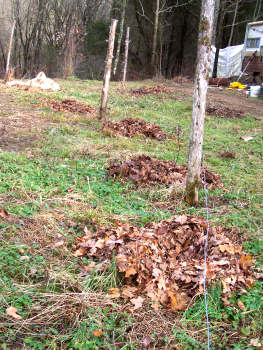
Mulching with black walnut leaves
 In a 500 square foot trailer, you have to be
pretty quiet not to wake up a guest sleeping on your futon. As a
result, I wandered outside into the morning drizzle to stay out of my
cousin's hair.
In a 500 square foot trailer, you have to be
pretty quiet not to wake up a guest sleeping on your futon. As a
result, I wandered outside into the morning drizzle to stay out of my
cousin's hair.
Squishing through
the mud, I found myself drawn to those big trash
bags of leaves Mom and Maggie collected for me this fall. Various
sources on the web had admonished me to shred my leaves before using
them as mulch, but when I began to shred them with the lawn mower a
couple of months ago the mower exploded. Nix that idea.
Instead, I decided to experiment with using whole leaves for
mulch. So I
spread some newspaper around each grape vine then doused the root zone
liberally with silver and sugar maple leaves.
I ripped into bag after bag, happy as a couch potato opening up potato
chips, until I came upon the first bag of black walnut leaves.
Then the second, the third. Yikes! Time to scurry back
inside and figure out what can safely be mulched with black walnut
droppings.
About a year ago at a party, someone who seemed very knowledgeable told
me that the juglone in black walnut parts is really only detrimental to
germination, but an extensive search of the internet showed no sources
which agreed with that assessment. Instead, most websites agree
that the juglone produced by walnuts messes with the metabolism of
other plants, causing them to wilt and exhibit stunted growth.
Some plants are tolerant to juglone in the soil, including onions (and
garlic, I hope, since it's in the same genus and I used black walnut
leaves on two of my garlic beds), beets, cucurbits, carrots, parsnips,
beans, corn, and the Prunus
genus (cherry, nectarine, plum, and peach.) So I moved on to my
nectarine, cherry, and peaches to use up the walnut leaves. I
hope my unshredded leaves work well as mulch --- I've had terrible luck in the
past with wood chips (even well composted) and am in need of a free
mulch that really does the job.
Want more in-depth information? Browse through our books.
Or explore more posts by date or by subject.
About us: Anna Hess and Mark Hamilton spent over a decade living self-sufficiently in the mountains of Virginia before moving north to start over from scratch in the foothills of Ohio. They've experimented with permaculture, no-till gardening, trailersteading, home-based microbusinesses and much more, writing about their adventures in both blogs and books.
Want to be notified when new comments are posted on this page? Click on the RSS button after you add a comment to subscribe to the comment feed, or simply check the box beside "email replies to me" while writing your comment.
